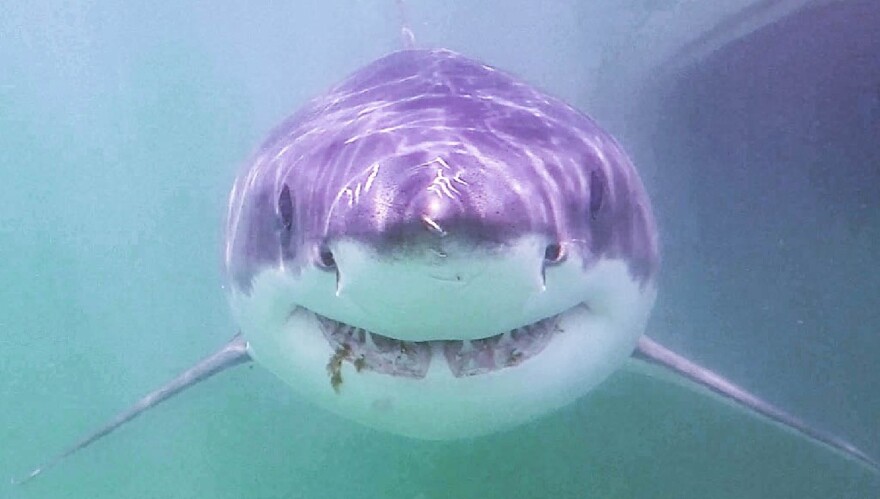This weekend marks 50 years since “Jaws” first opened in theaters in 1975. Tomorrow in Edgartown, an outdoor screening will put the music from the film in the spotlight, as the Cape Cod Symphony Orchestra plays the entire score, live, as the audience watches “Jaws.”
Norma Kelley, a cellist with the Cape Symphony for more than 40 years, sits in a conference room in West Barnstable, playing a few bars of one of the best-known movie themes of all time.
Dun-dun. Dun-dun.
“It’s just the three notes, mostly the E and F,” she says, drawing the bow across the the cellos strings to make those deep, menacing notes that signal the arrival of the shark in “Jaws.”
“But sometimes there’s a D thrown in.”
Dun-dun. Dun-dun, dun-dun.
For Jaws in Concert, the symphony will play the full John Williams score — including the recurring half-step motif that elicits a certain primal fear.
In interviews, Williams has recalled the first time he showed Stephen Spielberg what he had in mind. The two notes were so simple, Spielberg thought it was a joke.
But add the rest of the orchestra, and you get the ocean, the panic, the chase, and the eerie tranquility.

The main notes are an ostinato – a rhythmic pattern that repeats throughout the score. It appears in songs named for the action on screen, such as “Barrel Off Starboard” and “Brody Panics.”
Creating a motif and using different versions of it to tell the story follows a musical tradition that predates film itself, says Tim Huling. He’s a film composer who teaches screen scoring at Berklee College of Music.
“It comes from opera with composers like Wagner and others ... the idea of developing music across the story in a way that connects to deeper structures of the story," he said.
He says “Jaws” is a great example of the composer sort of tricking and manipulating the audience. Once Williams has made it clear that the half-step represents the shark approaching, he can choose key moments to leave it out.
“And so we get this extra shock when the shark suddenly appears and launches itself at the boat, and we haven't heard the half-step,” Huling said. “So he's a real master at thinking across the entire film and the experience of the audience.”
Of course, there’s a lot more to the Jaws score than those two notes.
Huling says some parts sound more subtly uncomfortable, cold, or intriguing.
“There are some other gestures that sort of sound like, almost like an alert, … like a reaction to the coming shark, the sort of, 'Da-da-da!' … like, ‘Uh-oh! What should we do?'"

Some of the more subtle moments in the score are supplied by the flutes and piccolos.
In her living room in Marion, symphony member Wendy Rolfe is demonstrating the flute part from the “Jaws” score.
During the movie, she’ll switch between piccolo, standard C flute, and the alto flute, which plays lower notes. Sometimes she has just five or six seconds to switch instruments.
“So you have that low, deep sound. You can think of the ocean,” she says, playing low, descending notes that sound placid, yet chilling.
When the symphony plays live with a movie, the conductor has to make sure they stay in sync. The music stops and starts, and the tempo can change suddenly.
Rolfe says this takes some practice.
“It's very interesting and pretty complex," she said. "Our conductor will be watching the score for the film on, I think, probably a laptop and probably will have some kind of an earphone to show the tempos and what's going on.”
Conductors of film scores often hear a click track that marks the beat.
Rolfe says it’s hard to believe “Jaws” was written 50 years ago; with sharks returning to the Cape and Islands in big numbers, the film feels so current.
She says one thing that’s changed is us: People are learning to live with ocean predators, “and understanding that they need to make a living, too, by eating seals and things.”
“We can also look back now and maybe be more sympathetic to the shark, because we understand that the shark is really just trying to survive,” she said.
The symphony’s show tomorrow is just one of countless events celebrating the 50th of everything “Jaws” — from the “bigger boat” to those two immortal notes.








